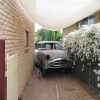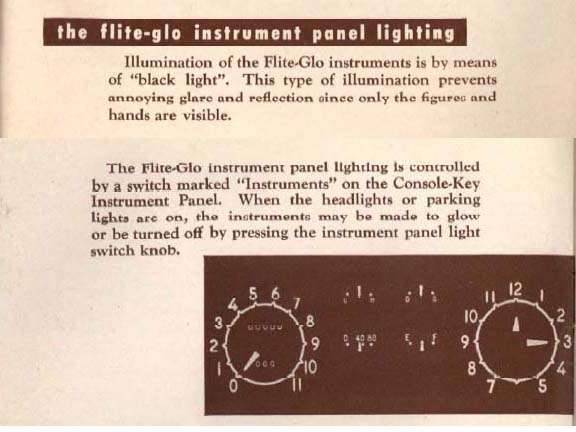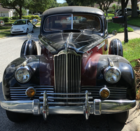|
1948-1949 Australian Motor Manual talks about Packard
|
||||
|---|---|---|---|---|
|
Home away from home

|
Thought I should post this small piece of Packard info in case anyone is interested.
Here are scans of a write-up in the Australian Motor Manual (Annual Edition) for '48-9 which gives an idea of how Packard was regarded here at the time. (This old publication is something I really enjoy having a read of occasionally). The preamble says: Free-flow styling has been indulged in with the new Packard with the result that the new look has all-but submerged the characteristic radiator. The imprimatur of the best of American automobiles is still apparent to discerning motorists whose habitual regard for this specie will this year be limited to viewing it from a distance. Only a straight eight is in production and its dash is alive with many press-buttons for automatic operations. Its new side valve motor develops 130 b.h.p. Dignified interior appointments include black-light instruments. (Shouldn't that be 'BACK-LIGHT instruments'? I checked the meaning of the word 'imprimatur' - probably means 'approved' or 'endorsed' here. I've only ever seen that word once before (- used elsewhere on this site by none other than su8overdrive!). This annual publication is interesting for a couple of reasons. It's giving an idea of what Australians were driving back then, and what was available. I think a few of these makes would be virtually unknown to people in the US(?) The scanned page (below) shows a typical list of what cars were generally available for purchase here at the time. It was a quite British-centric time here after WW2, with Ford (mainly small models like Anglia, Prefect but some V8's also), Morris, Vauxhall, Wolseley, Austin, Hillman etc (Rootes Group), Standard Vanguard and others being top sellers. There were American cars being driven here also (Chevrolet, De Soto, Plymouth, Pontiac, Chrysler) but they tended to be in the minority. 1948 was an important year for Oz car manufacturing, with the release of the GM Holden - the first supposedly 'fully Australian' production line car made here (based on a discarded Chev design). Holden soon became the most popular car, selling very well and displacing other makes for decades. Interesting that an Australian publication would use a Hudson graphic on the front cover.  A photo and also technical specs are included in the article. 39HP certainly eclipsed most other Australian cars back then. Somehow the 11.5HP Peugeot (adjacent page) seems quite insignificant by comparison.  The following list is in order of increasing cost. You can see that Packard was about the thirteenth most expensive car 'generally' available here in 1948. 
Posted on: 2012/7/4 8:04
|
|||
|
1951 Packard Club Sedan | [url=ht
|
||||
|
||||
|
Re: 1948-1949 Australian Motor Manual talks about Packard
|
||||
|---|---|---|---|---|
|
Home away from home

|
Thanks JD. Guess that this type of lighting would have been clever and very appealing back then. Was it a Packard 'first', or were other manufacturers using it also?
I remember that fluorescent numbers and hands had been used on watches prior to 1933 (- I have my father's old watch from back then)so it was not a new idea by 1948.
Posted on: 2012/7/5 6:31
|
|||
|
1951 Packard Club Sedan | [url=ht
|
||||
|
||||
|
Re: 1948-1949 Australian Motor Manual talks about Packard
|
||||
|---|---|---|---|---|
|
Home away from home
|
Supposedly the idea came from the instrument panels used in aircraft during WWII. I don't know if Packard was first... my first car, a 1952 Studebaker Commander, also had black lighted instrument gauges.
Posted on: 2012/7/5 9:39
|
|||
|
||||
|
Re: 1948-1949 Australian Motor Manual talks about Packard
|
||||
|---|---|---|---|---|
|
Forum Ambassador

|
I remember that fluorescent numbers and hands had been used on watches prior to 1933 (- I have my father's old watch from back then)so it was not a new idea by 1948.
Larry, actually those old watch dials weren't fluorescent, that would required the direct application of current to illuminate them. You might perhaps call them phosphorescent but in actuality I believe they used a low-grade radioactive paint containing radium.
Posted on: 2012/7/5 10:19
|
|||
|
||||
|
Re: 1948-1949 Australian Motor Manual talks about Packard
|
||||
|---|---|---|---|---|
|
Forum Ambassador
|
Just wondering if any of those who contemplated redoing their numerals with the "new" paint discussed in the last few months have finished. If so, how did the job go and does the stuff work satisfactorily?
Posted on: 2012/7/5 10:52
|
|||
|
Howard
|
||||
|
||||
|
Re: 1948-1949 Australian Motor Manual talks about Packard
|
||||
|---|---|---|---|---|
|
Forum Ambassador

|
low-grade radioactive paint containing radium.
There are reports that the workers applying that paint suffered severe illness, including dying.
Posted on: 2012/7/5 11:27
|
|||
|
||||
|
Re: 1948-1949 Australian Motor Manual talks about Packard
|
||||
|---|---|---|---|---|
|
Home away from home
|
The early glow in the dark numbers were painted on with a fine brush. I read the the workers who licked the brush to make it pointy died sooner from the radium.
Posted on: 2012/7/6 14:01
|
|||
|
Fred Puhn

|
||||
|
||||
|
Re: 1948-1949 Australian Motor Manual talks about Packard
|
||||
|---|---|---|---|---|
|
Forum Ambassador

|
Abstracting from Merck's Index, 9th Edition, 1976.
Radium is a brilliant white metal; most of the world's supply is found in Zaire (Belgian Congo). It is formed by the slow disintergration of Uranium. Radium's use for luminous paints has been discontinued (well before 1976). Inhalation or ingestion or body exposure may result in lung cancer, osteogenic sarcoma, osteitis, blood dyscrasias and skin injury. Radium autodisintergrates over time to form Radon (something many homowners have read about or dealt with.)
Posted on: 2012/7/6 14:40
|
|||
|
||||









